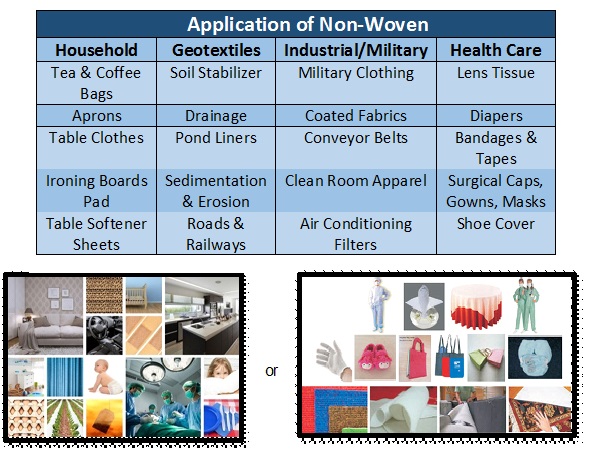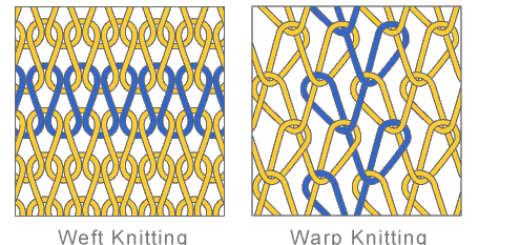| Design Engineering Theory Topics - Home Page |
Fibres and textiles
Textiles refers to all flexible fabrics created from fibres, which are fine, hair-like structures that can be made into fabrics by weaving, knitting or felting.
Fibres are either natural or synthetic (man made).
1 Natural Fibres
- Natural fibres fall into two categories - animal and vegetable.
Animal - Wool
- Made from animal fleece
- Made of protein molecules
- Produce short fibre or staple with a crimp or kink which, with the scales on the fibre, traps air, creating warmth.
- The first step in making wool fabric is shearing it from sheep, then its quality is checked and it is prepared for spinning.
- May be soft or course depending on the sheep breed.
- Examples applications:
- Coats, jumpers, suits, blankets, carpets and upholstery.
- Grey faced Dartmoor wool is suitable for carpet and rug making, while Merino is suitable for fine knitted jumpers.
- ADVANTAGES: Warm, absorbent, breathable, durable, repels rain, hangs well and creases drop out.
- DISADVANTAGES: Dries slowly, susceptible to moth attack, can feel itchy, washes poorly, can shrink and heavy when wet.
Vegetable - Plant cotton
- 'Bolls', the fruit cotton plant's fruit are machine-harvested.
- Saw teeth remove waste from the seed pod and the resulting fibre is called lint.
- Cellulose makes the fibre strong, durable and absorbent.
- As the cotton fibres dry they form interlocking flat, twisted, ribbon-like shapes, ideal for spinning.
- Example applications:
- Towels, denim, socks, underwear, T-shirts and bedding
- Short fibres make bandages and insulation
- ADVANTAGES: Cool, absorbent, soft, resists abrasion, withstands frequent washing at high temperature, good drape, durable, does not stain easily, static and cling resistant, available in various weights, can be ironed at high temperatures and good colour retention.
- DISADVANTAGES: Creases easily, burns, shrinks and dries slowly.
2 Synthetic fibres
Synthetic fibers derived from coal, air, water, and petroleum. Synthetic fibres are formed from a chemical reaction between an acid and alcohol.
Examples include: polyester, acrylic, polyamide (nylon), elastane (lycra) and Kevlar.
Polyester
- Polyester is a synthetic fiber derived from coal, air, water, and petroleum. Polyester fibres are formed from a chemical reaction between an acid and alcohol.
- Simple chemical molecules (monomers - a molecule that can be bonded to similar molecules to form long chains) are joined to form polymers by polymerisation.
- The polymer chains are spun into a yarn.
- Example application:
- Raincoats, fleece jackets, children's nightwear, medical textiles and working clothing.
- ADVANTAGES: Strong when wet or dry, dries quickly, resistant to abrasion, soft, hangs well, crease and stain resistant, easy care, can be recycled and resist bacteria.
- DISADVANTAGES: Damaged by acids, low warmth, poor absorbency, does not breathe and not environmentally friendly.
Acrylic
- Formed by polymerisation of at least 85% acrylonitrile or vinyl cyanide
- The double bond between the first two carbon atoms is broken and the molecules join in a chain.
- Example application:
- Imitation wool knitwear, upholstery fabrics, sportswear, fleece jackets and blankets.
- Acrylic can either be wet or dry spun. They use solvents to dissolve the polymer and then solidify them for their spinning process.
- ADVANTAGES: Warm, dries quickly, good drape, durable, crease resistant and easy care.
- DISADVANTAGES: Poor absorbency, feels stiff and can irritate skin.
3 Woven textiles
- Weaving is the primary way fabric is formed. Woven fabrics are formed by weaving threads over and under each other.
- There are many natural and man-made types of woven fabrics including denim, broadcloth, silk, satin, flannel and twill.
- Fabric thread can be made from cotton, linen, bamboo, polyester and even rayon.
- Weaving turns yarns into a fabric on a loom, which has the arrangement of a warp (vertical) threads held under tension.
- The edges where the weft (horizontal) threads loop back to form a non-fraying edge (selvedge).
Plain weave - Calico
- A simple cotton cloth, the warp and weft pass over and under each other, forming a criss-cross pattern that looks the same on both sides.
- Calico (muslin) is a natural grey colour, which can be either soft or course.
- Applications could be, shirts, bags, bedding and textile crafts.
- ADVANTAGES: It’s strong, hardwearing, hangs well, same on both sides, cheap to make, good background for printing and applied surface designs.
- DISADVANTAGES: It is firm and varies in quality.
Twill weave - denim
- The weft yarn goes over 2 or more warp threads, repeated on the row, but steps over one warp thread on the next rows to make a diagonal pattern.
- Denim is blue in the warp and white in the weft.
- Applications could be, jeans, jackets, curtains, blankets and soft furnishings.
- ADVANTAGES: Hard wearing, strong, hangs well, less stiff and more interesting to look at than plain weave.
- DISADVANTAGES: Frays, thickness makes it hard to use.
4 Non woven textiles

- Because it is a kind of form that does not require spinning weaving fabric, but the textile fiber or filament for directional or random support, the formation of the fibre network structure, and then the mechanical, thermal or chemical methods and strengthening into.
- Nonwovens break through the traditional textile principle, and have the characteristics of short process flow, fast production, high yield, low cost, wide use and many sources of raw materials.
- Fibres are layered at different angles to form a web, joined by either felting or bonding.
- Bonding joins the fibres with heat, solvents or adhesives, so is cheap to produce but not as strong as woven or knitted fabrics.
Felted wool fabric
- Scaly fibres of wool or hair become tangled as they are rubbed together when wet.
- Heat and pressure are applied to join them,
- Applications could be, pool table surfaces, hats, coats, slippers, applique quilts and wall hangings.
- ADVANTAGES: Resists chemicals and fire, does not unravel or fray, can be repeatedly compressed and released without deforming, excellent sound insulator and environmentally friendly.
- DISADVANTAGES: Expensive, no drape, not stretchy and deforms when wet.
Bonded fibres/webs
- Does not fray, weaker when wet, can be produced in a range of weights and not very strong.
- Applications could be, fusible interfacing, wet wipes and disposable overalls.
- ADVANTAGES: Does not fray, cheap to produce, stable and so retains its shape.
- DISADVANTAGES: Not very strong, does not drape and sometimes weaker when wet.
5 Knitted textiles

Weft knitted
- Weft knitting is the most common type of knitting, it is the process of making a fabric by forming a series of connected loops in a horizontal or filling-wise direction.
- It can be produced on both flat and circular knitting machines or by hand.
Uses:
- Tailored garments, like jackets, suits, or sheath dresses are made from weft knitting.
- Interlock knit stitch is wonderful for making T-shirts, turtlenecks, casual skirts, dresses and children's wear.
- Seamless hosiery, knitted in tubular form, is produced by circular knitting machines.
- Circular knitting is also used for the production of fabrics used in sports having high stretch ability and also dimensional stability.
- Knitted hats and scarves are used in the winter season are made through weft knitting.
- Industrially, metal wire is also knitted into a metal fabric for a wide range of uses including the filter material in cafeterias, catalytic converters for cars and many other uses.
Advantages
- Stretchy, comfortable, fast production
Disadvantages
- Ladders easily
Warp knitted
- Warp knitting is the process of making a fabric with a machine by forming the loops in a vertical or warp-wise direction; the yarn is prepared as warp on beams with one or more yarns for each needle.
- The fabric has a flatter, closer, less elastic knit than weft knit and is very often run resistant.
Uses:
- Tricot knit a type of warp knitting is used in the making of light weight fabrics usually inner wear like panties, brassieres, camisoles, girdles, sleepwear, hook & eye tape, etc.
- In apparel warp knitting is used for making sportswear lining, track suits, leisure wear and safety reflective vests.
- In household warp knitting is used for making mattress stitch-in fabrics, furnishing, laundry bags, mosquito nets and aquarium fish nets.
- The inner linings and inner sole linings of sports and industrial safety shoes are made from warp knitting.
- Car cushion, head rest lining, sun shades and lining for motorbike helmets are being made from warp knitting.
- For industrial uses PVC/PU backing, production masks, caps and gloves (for the electronic industry) are also made from warp knitting.
- Fabrics for printing and advertising are also produced from warp knitting.
- The warp knitting process is also being used for the production of bio-textiles. For example, a warp knitted polyester cardiac support device has been created to attempt to limit the growth of diseased heart by being installed tightly around the heart.
Advantages
- Fairly stretchy, retains heat, does not unravel
Disadvantages
- Can lose shape, curls at edges
6 Properties of textiles
Elasticity - amount of stretch
- tested by gradually increasing the force on the fibres until breaking point
- At low lods the fibres obey Hooke's law - stretch is proportional to the load and the fibres will return to their original shape.
- Clothes made from fibres that recover will maintain their shapes and not keep creases.
Resilience - resistance to being deformed or compressed
- Fibres should spring back vigourously when pressure has been applied.
Loft (compressional resiliency) is the ability to return to original thickness after being compressed or squashed, or to resist creasing.
Durability
Textile durability is how well a fabric resists wear and tear over time. It's a key quality that affects a fabric's appearance, lifespan, and consumer satisfaction.
Factors that affect durability:
- Weave: Fabrics with well-balanced patterns and yarns wear out more evenly.
- Fibre: Natural materials like cotton, canvas, and leather are durable.
- Tensile strength: Some fibers with high tensile strength include aramid, nylon, polypropylene, and polyester.
7 Recap
- Natural fibres come from plants and animals
- Synthetic fibres are artifically made from chemicals
- The two main types of weave are plain and twill
- Non woven fabrics are made by either felting or bonding
- Knitted fabrics are either warp or weft knitted.
Exam style questions
- Explain one benefit of using wool felt for constructing a hat
- Explain one disadvantages of using wool felt in a hat.
- Describe the advantages and disadvantages of cotton.
- Explain how felt is made.
- Devise a test for the resilience of different textiles
- Explain why a test for elasticity would be important when choosing fabrics for swimwear.